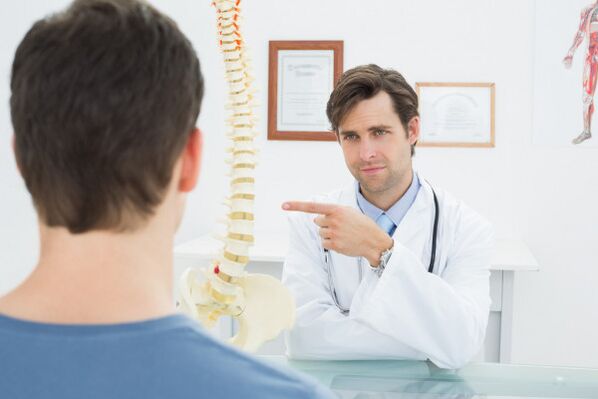Cervical osteochondrosis is a common form of the disease that affects the upper spine, causing specific symptoms at each developmental stage. Most patients will resolve the problem on their own without seeking help from a doctor.

Causes of cervical osteochondrosis
Secondary and tertiary osteochondrosis in the cervical region results in degenerative dystrophic changes in spinal tissue. First, the fibrin ring is destroyed, followed by herniation and prolapse of the disc nucleus. The pathology is accompanied by pain and dysfunction.
Causes that negatively affect the development of osteochondrosis of the spine and various degrees of cervical spine:
- Physical inactivity (sedentary work, minimal physical activity);
- genetic susceptibility to the disease;
- immune response problems;
- Unbalanced nutrition, leading to deficiencies in minerals, trace elements or specific vitamin groups;
- frequent hypothermia, a tendency to inflammatory processes;
- Systemic failure of the work of the endocrine system;
- Obesity at any stage;
- spinal cord injury;
- Hard physical labor.
Osteochondrosis of the neck region of the second and all subsequent degrees is considered the most severe. The reason is that the nerves and blood vessels responsible for nutrition and innervating the brain are located in close proximity.
More commonly, the pathology is found in people over the age of 50 with a diagnosis of 3rd degree cervical osteochondrosis.
What is Neck Osteochondrosis and Symptoms
Osteochondrosis is a dystrophic process that has devastating effects on the bones and cartilage that form the spine, as well as the nearby soft tissues.
As degenerative and destructive cervical lesions progress, the intervertebral disc loses its protective effect.
Gradual destruction, displacement of anatomical elements leads to negative consequences:
- The cartilage has partially or completely lost its depreciable properties;
- Disk deformation;
- Destruction of the annulus fibrosus (from the initial stage);
- Osteophyte formation - bone growth on the surface of the vertebrae.
Each degree of cervical osteochondrosis has specific manifestations. If in the initial stages (1st and 2nd stage) a person is troubled by mild discomfort, in the advanced stages, the disease can lead to many complications.

first level
1st degree cervical osteochondrosis may be asymptomatic. The patient's main complaint is neck pain.
Massage can help relieve discomfort. On palpation, the patient feels stiff muscles in the collar area with strong or moderate tension. If treatment is started promptly, the initial course of primary and secondary osteochondrosis abnormalities can be stopped.
second degree
The symptoms of second-degree cervical osteochondrosis are more pronounced. The exacerbation period is accompanied by severe discomfort. Complicated injection therapy is required immediately.
main performance:
- persistent headache;
- discomfort when moving the head;
- Movement stiffness in the neck collar area;
- During exacerbations, the pain syndrome can be stopped for a short time;
- lethargy;
- sleep problems;
- increased fatigue;
- Decreased level of work ability;
- Posture is affected and a person is unable to freely adopt a comfortable posture;
- Dizziness.
Appearance depends on which arteries, veins, or nerve bundles are pinched. The neck area and the muscles of the face, ears, and head become numb. The person may be disabled.
Three degrees
The third degree is characterized by active lesions of the annulus fibrosus.
Violation leads to the occurrence of herniation, intervertebral hernia.
The progressive stage of cervical disease is characterized by a marked pain syndrome that cannot always be stopped with strong analgesics. Neurological disease progresses gradually.
fourth degree
In the final stage, the degradation destruction process reaches its peak. The patient has difficulty moving, and the stiffness is at its maximum. Sometimes the pain may subside, but this is a red flag. Bone tissue begins to grow between the vertebrae, which will lead to greater deterioration, worsening health.
stage diagnosis
Spinal disc instability, issues related to eliminating the consequences of tissue destruction are considered by neurologists. Doctor checks neck reflex with hammer, coordination test.
Instrumental research:
- radiography;
- CT scan;
- Magnetic resonance imaging;
- Vertebral artery ultrasound.
X-rays are taken from the front and side.
MRI and CT are informative research methods. The only downside is the high cost of surgery.
If necessary to determine the extent of damage to the vertebral arteries, an ultrasonography is performed to assess the condition of the neck region of the spine. The results will help shape the prognosis of the disease.
Treatment of secondary cervical osteochondrosis
The basis of any therapeutic effect for cervical osteochondrosis is the administration of drugs that help to get rid of the manifestations of the disease. Treatment options are determined by several specialists - therapists, neurologists.
anesthesia of the patient
Treatment of patients with secondary cervical osteochondrosis begins with a pain medication complex. Doctors choose analgesics from the perspective of their effectiveness and the patient's contraindications.
fight inflammation
Anti-inflammatory drugs help to eliminate inflammatory lesions and reduce pain levels in patients with cervical osteochondrosis.
NSAIDs have a negative consequence - they positively affect the mucous membranes of the digestive tract.
Non-steroidal anti-inflammatory analgesics can be prescribed in tablets or injections, as in exacerbations of osteochondrosis in stages 2 and 3. Typically, gels, ointments, creams are used for external treatments.
chondroprotective agent
Protectors of cartilage and bone tissue are given a special role in the treatment regimen for secondary cervical osteochondrosis.
Operation
If treatment of second- or even third-degree cervical osteochondrosis is performed at home, radical treatment requires the patient to be hospitalized. Indications for surgery:
- spinal instability;
- spinal cord compression;
- Hernia formation.
With the progression of osteochondrosis, the problem of pathological destruction of the neck cannot be completely resolved.
Therapeutic gymnastics and exercise therapy
If the functional potential of the spine cannot be fully restored, it is possible to stop the progression of the disease.
In the early stages (first and partial second degree cervical osteochondrosis), simple folk methods, therapeutic exercises will help. Such recreational activities are inexpensive, easy to perform, non-painful, and non-discomfortable.
Gymnastics and exercise therapy are recommended in the later stages of the formation of secondary or tertiary cervical osteochondrosis. The exercises are carried out under the supervision of experts. Doing the right thing is important. Main goal: To strengthen the neck muscles while relaxing.
It is important that the patient works hard to recover and carefully follows the advice of the specialist, the prescription of the doctor.






























